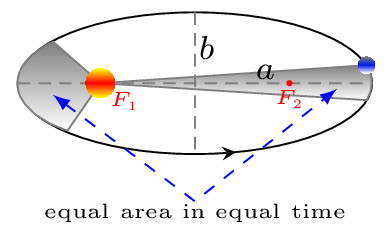Section 6.2 Kepler’s Laws of Planetary Motion


The asymmetric position of a massive object within the elliptical orbit renders the orbiting object moves in a varying distance from the massive object. The distance of closest approach \(d_{1}\) is called the periapsis and the distance of maximum separation, \(d_{2} \) is called the apoapsis. For the earth around the sun perihelion is the distance of closest approach and "aphelion" is distance of the maximum separation (helio means sun in Greek) [Figure 6.2.1.(b)]. For earth-moon system, "perigee" is the distance of closest approach and "apogee" is distance of the maximum separation (gee means earth in Greek).
Johannes Kepler established three laws for planetary motion from his and Tyco Brahe years of sky gazing in early \(17^{th}\) century. They are
- The law of orbit: In Solar system, every planet revolves in an elliptical orbit and the Sun being at one of its focii [Figure 6.2.1.(a)].
- The law of area: Planet sweeps out an equal area in equal interval of time in the orbit [Figure 6.2.1.(b)].
- The law of period: The square of time period of planet around the sun is directly proportional to the cube of semi-major axis.
